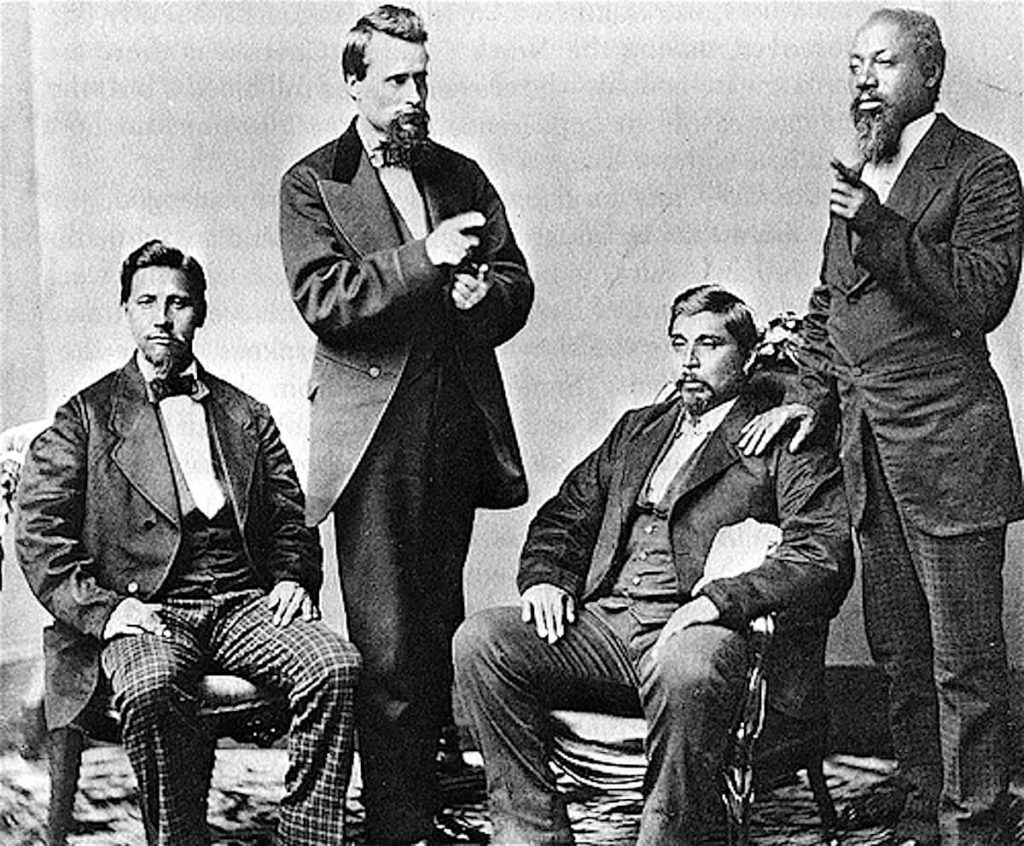Black settlement in Oklahoma is linked with Indian removal beginning in the 1830s, when the federal government forced members of the Five Civilized Tribes—the Cherokee, Chickasaw, Choctaw, Creek, and the Seminole—to leave their territorial homelands in the Southeast and relocate to Indian Territory (present-day Oklahoma).
In Indian Territory, African Americans could settle alongside the thousands of free African-Native Americans (a/k/a Native Blacks) that were citizens of the Five Tribes. In 1833, the Lower Creek Indians of the Alabama settlement of Tallasi were forced to relocate to Oklahoma in the area that is present day Tulsa. The Lower Creeks carried the ashes from the last council fire held in their ancestral homelands on their forced march to Oklahoma, deposited them under a large oak tree, and named their new home Tallasi, which translates to “Old Town.” The name Tulsa came from a shortened pronunciation of Tallasi and was originally “Tulsey” or “Tulsee.”[1]
At the end of the Civil War, newly emancipated African Americans suffered from so much hostility that, as scholar Michael Eric Dyson writes, “Black folk were always on the move, throwing off oppression like stifling clothes and inhabiting new lands with old hopes of freedom.”[i] The search took them to Kansas, Canada, Mexico, and even Africa. But it was Oklahoma that got the most attention from freedom-thirsty African Americans.[ii] Newly freed African Americans viewed Oklahoma, then known as Indian Territory, as the most sensible place to start their new lives.
In 1889, President Harrison made a section of the Indian Territory called the Unassigned Lands available for resettlement.[2] Whites and freed Blacks, many of whom left the South after Reconstruction officially ended in 1877, began to migrate and settle new homes in the Indian Territory.[3] In 1890, the U.S. Congress declared the western half of the Indian Territory, Oklahoma Territory. Thereafter the two territories became known as the Twin Territories.[4]
Freed Blacks saw the Twin Territories as a “Promised Land.”[5] There they could escape from the political, economic, and social oppression southern lawmakers institutionalized through the passing of racist legislation and southern whites upheld through increasingly prevalent acts of extralegal violence in the wake of the Civil War.
Before Oklahoma Statehood in 1907, most Native Blacks in what is now known as Northeastern Oklahoma had lived as first-class citizens within their Native Nations for at least forty years due to post-Civil War Treaties. This coupled with the fact that they could own land and exercise their right of self-determination in the Territories allowed Native Blacks to build wealth, independent communities, and own valuable mineral rich land.[6] This combination of land ownership, freedom mind state, and wealth concentration gave birth to Greenwood—the most prosperous, organized, and successful Black community in United States history.
Between 1865 and 1920, freed Blacks established thirty-two all-Black towns in America. Freed and Native Blacks settled twenty-eight of these Black townships within the Twin Territories and even started a movement to make the territory an all-Black state.[7] These towns became sanctuaries from the racial discrimination and violence found in mixed-race towns throughout the American South, where African Americans could enjoy economic security and mutual protection.[8]
Among these all-Black towns within the Territories, Greenwood was a mecca to which thousands of Black people from the surrounding townships flocked. Some came to Greenwood to procure goods, services, and experience the vibrant culture, while others came to establish new lives and build wealth for themselves, their families, and their community.
[1] Carl E. Gregory, “Tulsa,” The Encyclopedia of Oklahoma History and Culture, accessed February 12, 2018, http://www.okhistory.org/publications/enc/entry.php?entry=TU003; “What is the meaning of the name ‘Tulsa’?” Local/Municipal Government: Tulsa Area FAQs, Tulsa County Library, accessed January 5, 2018, http://guides.tulsalibrary.org/c.php?g=695427&p=4931218#9395804; “Tulsa and Oklahoma History in the Research Center: Tulsa Timeline,” Tulsa County Library, accessed January 5, 2018, http://guides.tulsalibrary.org/c.php?g=695416&p=4931569.
[2] Stan Hoig, “Land Run of 1889,” The Encyclopedia of Oklahoma History and Culture, accessed January 2, 2018, http://www.okhistory.org/publications/enc/entry.php?entry=LA014.
[3] Jimmie Lewis Franklin, The Blacks in Oklahoma (Norman: University of Oklahoma Press, 1980), 4-5
[4] James Hirsch, Riot and Remembrance: The Tulsa Race War and Its Legacy (Boston, Massachusetts: Houghton Mifflin, 2002, Kindle edition), Kindle location number 489.
[5] Eddie Faye Gates, They Came Searching: How Blacks Sought the Promised Land in Tulsa (Austin, Texas: Eakin Press, 1997), p. 31.
[6] Charles F. Barrett, Oklahoma After Fifty Years: A History of the Sooner State and its People 1889-1939 (1941).
[7] Hannibal Johnson, Black Wall Street: From Riot to Renaissance in Tulsa's Historic Greenwood District (Fort Worth, Texas: Eakin Press, 1998, Kindle edition), Kindle location numbers 151-165.
[8] Franklin, “All-Black Towns.”
[i] Hannibal Johnson, Acres of Aspirations 14 (2002).
[ii] John Hope Franklin & Alfred A. Moss, Jr., From Slavery to Freedom: A History of African Americans (7th ed. 1994).
